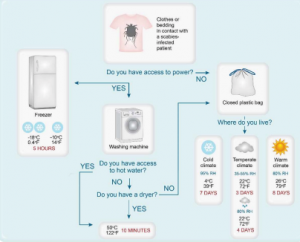Although scabies infestation is usually transmitted by skin to skin contact, Queensland researchers have validated methods to prevent transmission by other means such as via viable parasites on bedding and clothing.
They say cases of scabies observed in laundry workers and also apparent cases of ‘treatment failure’ show scabies mites may survive in the short term on inanimate objects, particularly in cases of profuse or crusted scabies.
Therefore researchers in the Infectious Diseases Program of the QIMR Berghofer Medical Research Institute, Brisbane, used scabies mite and egg samples derived from pig models to assess the factors in survival of viable scabies parasites under different environmental and washing conditions.
They found that the threshold for killing all parasites and eggs was exposing them to temperatures of >50 degrees C for more than ten minutes . This could be achieved with conventional washing machines or heat drying, and there was no additional benefit of using detergent for disinfection or ‘ozone laundry’ sterilisation, they found.

Photo: JAAD
Other effective methods for inactivating scabies parasites and eggs included freezing below -10°C for at least 5 hours, or isolating them in a bag for either three days (temperate-dry conditions) or a maximum of eight days in warm-humid conditions.
They said the preliminary findings could be useful information to combat ongoing scabies transmission problems such ain s Indigenous communities in remote Australia, where there may be limited access to electricity or laundry facilities.
Further studies with techniques such as hot ironing and stem cleaning have yet to be investigated, they added.
The findings are published in the Journal of the American Academy of Dermatology.